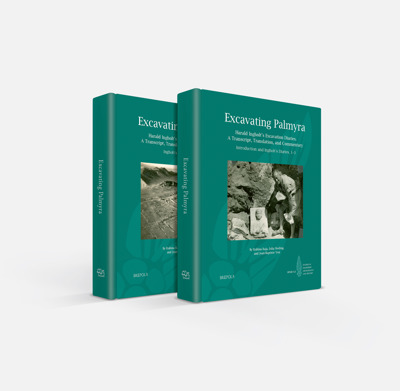
Palmyra and the East
Kenneth Lapatin, Rubina Raja (eds)
- Pages: xx + 181 p.
- Size:216 x 280 mm
- Illustrations:103 b/w, 3 col., 6 maps b/w
- Language(s):English
- Publication Year:2022
- € 85,00 EXCL. VAT RETAIL PRICE
- ISBN: 978-2-503-59825-3
- Paperback
- Available
The contributions in this volume focus on the rich archaeology and history of the oasis city Palmyra in the Syrian Desert in the first three centuries CE.
“Showcasing some of the rich archaeology of the Palmyra region, this volume offers a timely reminder of the consequences—both humanitarian and in terms of heritage—of the ongoing civil war. The contributions are divided into two parts: ‘Language, History and Trade’ and ‘Art and Archaeology’, bound by the overall theme of Palmyra as a nexus of trade and encounter between the Mediterranean, the Near East and India.” (Claire Nesbitt, in Antiquity, 97, 2023, p. 258)
“With rich discussions on various issues relating to the Palmyrene and neighbouring cultures, the reviewed volume is an important voice contributing to the perception of the region’s “Easterness”, often overshadowed by approaches that privilege the impact of the “Classical” civilizations. Aleksandra Kubiak-Schneider, in Bryn Mawr Classical Review, 30.05.2024)
« Cet ouvrage, magnifiquement illustré en noir et blanc, largement dominé par l’aspect artistique, superbement fiché, complète une série de travaux antérieurs et rendra service à ceux qu’intéresse la collection des vestiges funéraires. » (Daniel Bonneterre, dans Histara, 23/07/2024)
Kenneth Lapatin is curator of antiquities at the J. Paul Getty Museum in Los Angeles and has written extensively on the art of the Roman Empire and curated numerous exhibitions on the art and culture of the Roman world.
Rubina Raja is professor of Classical Archaeology and centre director of Centre for Urban Network Evolutions at Aarhus University. She heads several research projects on Palmyra. Together Lapatin and Raja have curated an exhibition on Palmyra and organised the symposium Palmyra and the East at the Getty Villa in 2019.
The ancient caravan city of Palmyra, although located in the Syrian Desert, was very much a cultural locus, a place where peoples, goods, and ideas met and mingled from as far afield as Europe to the west and India and China to the east. It was a city that stood balanced between the power of the Roman Empire to one side, and the Parthian Empire to the other. Yet despite the city’s location at a cultural crossroads, and its greater proximity to Parthia than Rome, scholars focusing on Palmyra have traditionally focused on links with the west, while relatively little attention has been paid to the threads that wove a connection between Palmyra and regions further to the east.
This edited volume seeks to address this lacuna in scholarship by offering an in-depth exploration of Palmyra’s connections with its eastern neighbours in the first three centuries ad. The papers gathered here examine the city’s art, architecture, and material finds, its languages and inscriptions, its political interactions, social life, and religious identity from a time when Palmyra was at the height of its powers in order to shed light on the city’s own distinctive identity, as well as its close — and often tense — relationships with Parthia and beyond. Together, these contributions offer fascinating new insights into Palmyra’s dynamic relationships with the regions to its east, as well as on how these influences underpinned and were diffused throughout Palmyrene culture.
List of Illustrations
List of Abbreviations
Introduction — Palmyra and the East: Reassessing an Oasis City and its Cultural Relations
KENNETH LAPATIN and RUBINA RAJA
Part I. Language, History, and Trade
1. Language as Power: Aramaic at (and East of ) Palmyra
CATHERINE E. BONESHO.
2. Palmyra’s Maritime Trade
KATIA SCHÖRLE
3. From Palmyra to India: How the East Was Won
JEAN-BAPTISTE YON
4. Palmyra and the Sasanians in the Third Century AD
TOURAJ DARYAEE
5. Zenobia and the East
NATHANAEL J. ANDRADE
6. The Fate of Palmyra and the East after AD 273: A Few Remarks on Trade, Economy, and Connectivity in Late Antiquity and the Early Islamic Period
EMANUELE E. INTAGLIATA
Part II. Art and Archaeology
7. Palmyrene Funerary Art between East and West: Reclining Women in Funerary Sculpture
RUBINA RAJA
8. Ashurbanipal and the Reclining Banqueter in Palmyra
MAURA K. HEYN
9. So-Called ‘Servants’ or ‘Pages’ in Palmyrene Funerary Sculpture
FRED ALBERTSON
10. Notes on Some Palmyrene Religious Imagery
TED KAIZER
11. A Palmyrene Child at Dura-Europos
LISA R. BRODY
12. Edessa and the Sculpture of Greater North Mesopotamia in the Romano-Parthian Period
MICHAEL BLÖMER
Index




